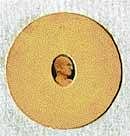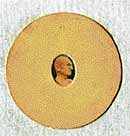

Fifty-nine year old Tejinderpal Singh Saini is no connoisseur of art. He is burdened, though, with a collection of rare miniature works, gifted to him by an ailing uncle, whose worth he hardly realized over the years as they laid in a corner of his house.
Only in recent years when he showed the collections to aficionados in the art world and many of them tried to entice him to part with his collection that he realized the preciousness of his possessions.
What Saini is looking for, though, is an authentic buyer who would peg a fair value to the rare nail-sized works of his artist uncle, Joginder Nath ‘Susheel.’ “Several connoisseurs have come and put varied price tags on these paintings- starting from thousands to a few lakhs. I really do not know what their true worth is. Some say they are worth crores,” says Saini.
Alarmed by attempts of certain bigwigs from the art world to “poach” on the miniature collections by hook or by crook, Saini has now put them into a bank locker for safekeeping. He has got them photographed on a CD and does not bring out the originals ever since one of his foreign acquaintances tried to steal them from his house.
“I never realized the value of the paintings dating back to the 19th century till much later in life. My uncle handed them over to me out of sheer affection”, says Saini. He was then a 10 year old boy and the only human contact with his ailing uncle who had otherwise been isolated by other family members for several years.
Susheel, an alcoholic, was an artist of some repute at Lahore before Partition. Saini says his uncle, an amateur artist, had won acclaim in the art world of Lahore. “Besides the three miniature paintings, he also left with me 60 collections of his art work, mainly depicting the pain and agony of the Partition,” he says. Susheel died in 1965, a forgotten and unsung artist.
Antiquities
It is the three miniature paintings of Susheel, though, that are worth a fortune. These have been registered as antiquities under the Antiquities and Art Treasures Rules, 1973.
One of them depicts Mahatama Gandhi, another is a portrait of Queen Mary –II of England and the third shows the wife of Nizam of Hyderabad. Painted by using hair from the eyelashes, the miniature paintings are 1.2cm in height and 0.9 cm in width.
“Another peculiarity is that these have been drawn on hand-made paper rolled by my uncle and vegetable colours have been used ,” Saini says. In other paintings of Susheel in the possession of Saini, the pain, anguish and atrocities of the Partition come out alive in portrayals of homeless people and women ,besides children getting killed in the communal frenzy.
In another portrayal, the artist pours out his angst against the English rulers of the period and seeks to demonise Churchill and Queen Victoria. Saini says, “these paintings are poignant with meaning and stand out as artistic expressions of a bloody period in sub-continent's history.”